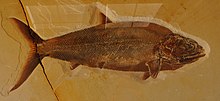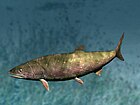|
Caturus
Caturus (from Greek: κατω kato, 'down' and Greek: οὐρά ourá 'tail')[1][2] is an extinct genus of predatory marine fishes in the family Caturidae in the order Amiiformes, related to modern bowfin. It has been suggested that the genus is non-monophyletic with respect to other caturid genera.[3] Fossils of this genus range from 200 to 140 mya (Early Jurassic to Early Cretaceous).[4][5] TaxonomyCaturus has a confused taxonomic history. The genus was originally described by Louis Agassiz for two fossil fish (U. pachyurus and U. gracilis) that had been previously described in the genus Uraeus, which was found to already be preoccupied by a genus of cobra of the same name (now classified as a subgenus within Naja). However, neither of these species were properly described with an associated illustration or proper description, and they remain nomen dubia; the specimen of U. pachyurus is lost, and the specimen of Caturus gracilis is too poorly-preserved to assign a specific taxon. Later, the species C. furcatus, initially described by Agassiz within Pachycormus, was designated as the type species of the genus by Woodward, but this was incorrect as the type species of a genus must be one of the species originally described for it. These inconsistencies make both Caturus and Pachycormus (which was initially described with Uraeus gracilis as one of its species) taxonomically unstable genera, necessitating a petition to the Bulletin of Zoological Nomenclature to retain C. furcatus as the type species of Caturus.[4] Species The following species are known:[4]
A number of species are no longer recognized. The species C. angustus Agassiz, 1844, C. branchiostegus Agassiz, 1834, C. brevicostatus Münster, 1842, C. contractus Wagner, 1863, C. driani Thiollière, 1851, C. elongatus Agassiz, 1834, C. gracilis Wagner, 1863, C. maximus Agassiz, 1834, C. microchirus Agassiz, 1834 and C. pleiodus Agassiz, 1844 are considered nomina dubia, while C. fusiformis Wagner, 1863 is considered a nomen nudum. The species C. stenospondylus Sauvage, 1875, C. stenoura Sauvage, 1875, and C. chaperi Sauvage, 1883 are all considered synonyms of Pachycormus macropterus, while C. cotteaui Sauvage, 1875 is considered a synonym of Euthynotus intermedius. The species C. retrodorsalis Sauvage, 1891 has been reclassified in Pholidophorus. Other species such as C. giganteus (Wagner, 1851) have been reclassified into other genera within the family Caturidae, such as Strobilodus. The species C. brevis Winkler, 1862, C. latidens Woodward, 1918, and C. velifer Thiollière, 1851, are no longer classified in Caturus or even Caturidae, and are yet to be reclassified.[4] The species C. insignis from the Triassic of Austria, formerly placed in Caturus, is now placed in the genus Furo. Another potential record from Argentina is now placed as an indeterminate caturoid, possibly in the genus Catutoichthys.[4][5][6] DistributionWhen restricted to only definitive species, Caturus is present in the Jurassic of the United Kingdom, Germany, the United States, and Cuba, ranging into the earliest Cretaceous of the United Kingdom and Spain. Indeterminate remains are also known within this range from the Jurassic of France and Portugal.[2][4] References
|
||||||||||||||||||||||||||||||||||||||||



